
Rise of the Neuromorphic Machines
By George Steber View In Digital Edition
Prologue
In the future, according to a recent technical report [1], neuroscientists will finally unlock the secrets of the human brain and create robots that think and act like we do. The breakthrough will come when the brain has been completely reverse-engineered and integrated with the latest in neuromorphic computing.
To be worthwhile, such a machine will need common sense. If it feels that you are in pain or confused, it will aptly alter the way it interacts with you. When acting autonomously, it will be aware of its environment and suitably alter its mission. If it’s walking down the sidewalk and sees a little girl falling off her bicycle, it will respond like any human would in this situation. If it accompanies you to a musical play, it will be able to discuss its music, acting and artistic merits, perhaps over a glass of wine at the local pub.
Now we come to some seemingly unanswerable questions. Will the robot actually take pleasure in helping a human or watching a play? Would we even know if it does?
These questions are rooted in what is called machine consciousness. How do we create consciousness when we don’t understand it or its objective in humans? Why do we feel gladness when we look at the stars, see a close friend, climb a mountain, or kiss in the moonlight?
Human consciousness is probably the greatest thing that has ever evolved. If we manage to create it in machines, it will unquestionably be mankind’s greatest accomplishment, changing the way we look at ourselves and the future of our universe.
Some may have qualms about machines with human-like intelligence and consciousness. Some are certain they will be friendly and care-taking. Others feel there is a huge potential for misuse with bad selfish robots taking over the world. After reading this short story, you may look at the situation differently.
Sometime in the Future ...
After a long and tiring day at Neuroco, Gary is in his autocar riding home. It feels good to relax and close his eyes for a little while. His autocar will take him home without assistance. In the meantime, he could catch up with his messages. But why bother? Lani has probably taken care of that. Anyway, his head is still too full of the new neuromorphic project at work to listen to messages.
It was time to clear his head and consolidate his thoughts. The work on neuromorphic computing at Neuroco had succeeded even beyond their dreams. His group had been working on a thinking machine that would solve the oldest problem of the computer age: a machine that could plan and reason like a human.
It had now been over seven years since their first success was produced: a working synthetic neocortex. They had hoped it would be incorporated into some form of robotic brain. However, management decreed otherwise, and it was shipped to a secret robotics facility in another country for further work.
Whatever happened to it there was anyone’s guess. Gary often wondered if he would ever see his creation again, possibly in the form of a beautiful, intelligent hubot. But that was the past and they had now moved on to other projects. Even so, the glow of that achievement still lingered in his memory.
There was a big gap between Neuroco’s synthetic brain and yesterday’s computers. Most early efforts centered on computer simulations of the brain.
The old K supercomputer was one of the first efforts at brain simulation. It was extremely large by today’s standards, having 672 computer racks with 68,542 CPUs while consuming over nine megawatts. It could simulate 1.73 billion neurons, but was extremely slow since it needed to solve billions of equations describing the dynamics of networks and cells across a membrane.
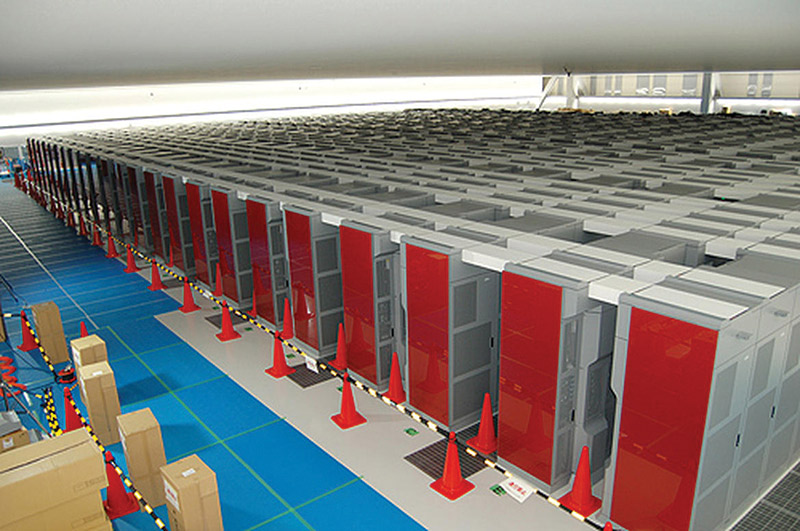
K Supercomputer. The first major brain simulation was carried out in a Japanese K supercomputer in 2014. The project was a joint enterprise between the Japanese research group RIKEN, the Okinawa Institute of Science and Technology, and Forschungszentrum Jülich (a research center based in Germany). (Courtesy of Fujitsu.)
We now know that is not the best way to build a thinking machine. Computers that exclusively used Boolean logic are just not very efficient at emulating a brain.
The next step was to abandon microprocessors and use a neuromorphic computing system with memory and computation intertwined. The IBM TrueNorth chip — while still a fully digital system — was based on custom neural circuits that implement a neural model. Its neurosynaptic core contained groups of neurons in a two-layer network.
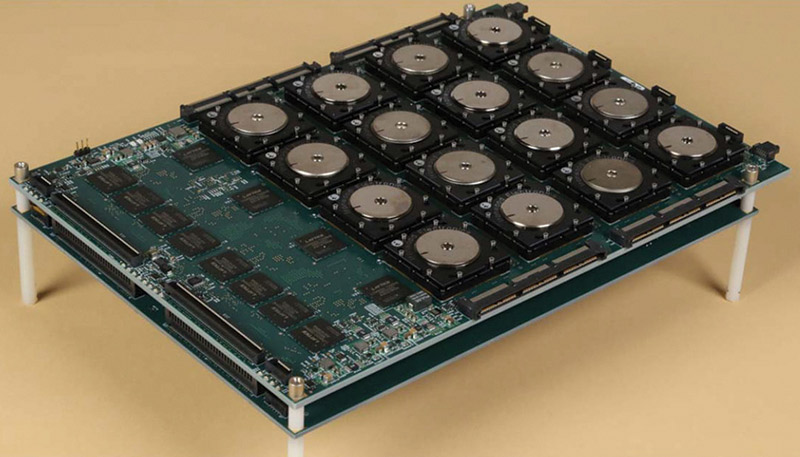
DARPA SyNAPSE 16-chip board with IBM TrueNorth. TrueNorth is a neuromorphic CMOS integrated circuit produced by IBM in 2014. It is a many-core processor network on-a-chip design with 4,096 cores, each one simulating 256 programmable silicon "neurons" for a total of just over a million neurons. (Courtesy of Wikipedia.)
Those neurons were mapped to spiking neurons connected by grid-like synapses to other neurons. A spiking neuron played an analogous role to a logic gate. Spikes were essentially electrical impulses that were formed and transmitted along the network. These and other inputs were then processed by the neural network. Neuroengineers back then used neural networks since they enabled a computer to learn from observational data.
However, it was not clear what a neuromorphic system would do except possibly some brain research. About this time, a method of applying computational models for multiple layers was developed that made dramatic advances in classic computing. This approach came to be known as deep learning. It held much promise and delivered good results in pattern recognition applications.
Unfortunately, deep learning failed to deliver on the promise of producing a computer with reasoning and language skills, like HAL9000 in the movie, 2001: A Space Odyssey. Nonetheless, it provided a stepping stone to unique low powered neuromorphic technology that caused neuroengineers of today to consider completely different alternatives.
The advance happened because the neuroengineers at Neuroco looked at the brain as a vastly different type of computer — one that may be bad at crunching numbers, but a wonder at processing information from our surroundings. The brain’s greatest ability is to learn from the world, to plan, and to execute. One component of the brain — the neocortex — is responsible for this intelligence. Only humans and other mammals have a neocortex.
In the human brain, the neocortex is the largest part of the cerebral cortex which is the outer layer of the cerebrum. It takes up about 75 percent of the brain’s volume, and contains both excitatory and inhibitory neurons named for their effect on other neurons.
Amazingly, at birth, the neocortex knows nearly nothing. It must be taught through experience. Everything we learn about the world — from eating, to walking, to playing with objects — is stored in the neocortex. This information (mainly in the form of patterns) is stored by forming new synapses in the neocortex. This enables you to recognize objects and recall them from your memory.
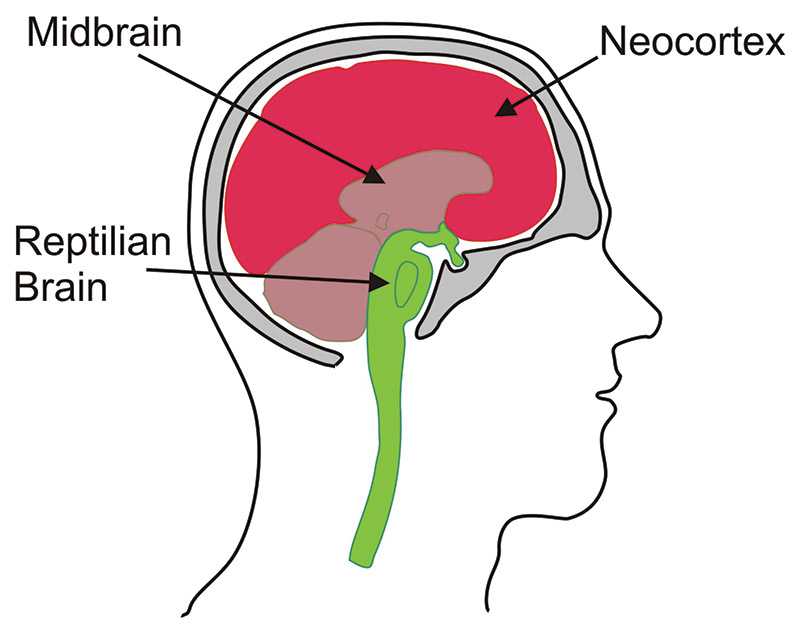
Simplified model of the human brain. The reptilian brain controls breathing, hunger, survival, and reproduction. The midbrain is responsible for memory, sociability, attack, anger, love, anxiety, fear, and hate. The neocortex is responsible for logic, analysis, rational behavior, emotions, language, and morals.
As might be expected from this process, the neurons become connected in highly intricate patterns. A typical neuron has a single tail-like axon and tree-like extensions called dendrites.
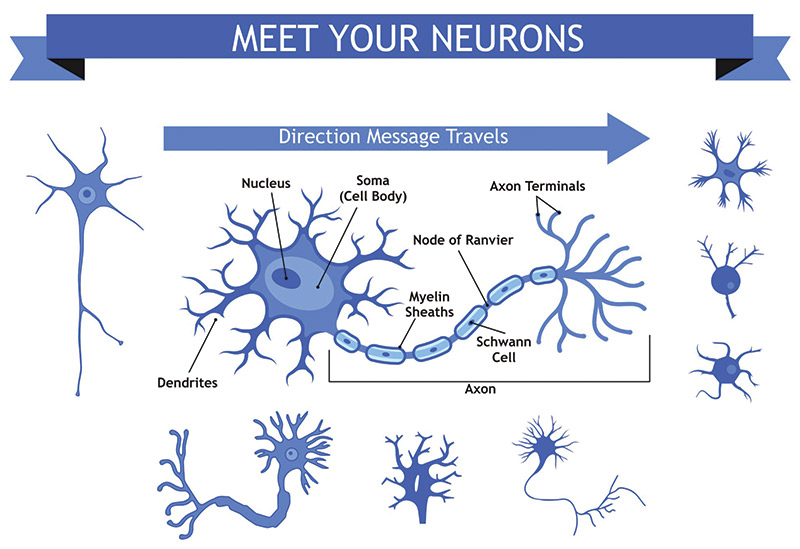
Neurons. Neurons are electrically excitable cells that link up with one another, sending electrical signals through complicated circuits that span the body, spinal cord, and brain. Each of the brain’s 86 billion neurons can connect to numerous others. Neurons receive incoming signals from structures called dendrites, and output signals through its long axon.
In the past, neuroscientists believed that learning occurred solely by modifying existing synapses, by altering the probability that cells would fire. Now it is known that most learning results from growing new synapses between cells; in effect, rewiring the brain.
These new synapses form new patterns and therefore new memories.
When a neuron learns a new pattern on one of its dendrites, its branches are nearly independent and it doesn’t interfere with other patterns it has learned. Hence, the brain does not need to be re-trained every time something new is learned.
These and other attributes of the neocortex were well known at Neuroco. The breakthrough came when Gary’s group learned how to synthesize an artificial neocortex using 3D microscopic printing, enabling them to build a realistic version of the human brain that could learn from its surroundings.
A telltale bump in the driveway disturbed his reverie, signaling that he had arrived home. As the autocar was being parked in the garage, Gary began to look forward to a nice relaxing evening at home. Perhaps after dinner they could listen to an old “Bix” Beiderbecke record from the 1920s. Lani was sympathetic to his passion for old records but sometimes groused just a little bit.
“I don’t understand why you like that metallic sound. We could easily have it enhanced to quadraphonic making it more listenable.” Still, Gary felt that secretly, she liked the old records too, in spite of their tinny sound.
As he approached the front door, the auto-recognition system signaled its approval and unlocked the latch. As a neuroengineer, Gary worked with the most complex instruments on the planet. At home, he was content to live with only the bare essentials. The auto-recognition system was one of his concessions to modern times.
Their home was located in a natural wooded area on the outskirts of the city. Behind it was a small pond where little creatures, squirrels, geese, and rabbits congregated. It was a modest house by most standards — much less than their large stipends from Neuroco could easily provide for — but it suited them perfectly. It had the usual rooms, including a smart kitchen primarily for Lani, and a media room for Gary’s collection of old movies and records. Gary did not like modern movies produced by artificial intelligence. They seemed, well ... too artificial.
On another level, there was a small workshop where he and Lani could work on their various projects. Gary liked to tinker with things, and Lani liked freehand drawing and scrapbooking. In another concession to modern life, they each had a small office with a photonic connection to Neuroco to be used on days when they worked from home.
Opening the door, Gary saw Lani sitting in a comfortable old chair by the fireside. It looked like she had just finishing one of her drawings.
“Hi Lani, I’m home.” She looks his way and gives an appreciative smile. He gazes at her, seemingly for the first time.

HI LANI, I’M HOME. Lani welcomes Gary home after a hard day at work. (Courtesy of Burge Vaughn)
They had met a few months ago at Neuroco while working together on a project involving one of Gary’s ideas: the neuro-physician. She was a new staff member, a bio-physicist, tasked with creating the neocortical neuron’s dendrite, axon, and soma components while maintaining biological fidelity.
He first saw her through the laboratory window leaning over a counter, looking at a computer screen in the deserted room. She was a medium curvaceous girl in a blue uniform carefully chosen to fit to her best advantage. Soft brown hair tumbled back from a tanned healthy face that sported only a trace of lipstick.
Her wide steady gaze flicked up as he strode in, then she smiled warmly. “Hi, I’m Doctor Lani Ross. You must be Doctor Mitchell.” “Let’s keep it informal. Please call me Gary.”
Working together for long periods often put them in close contact, and a friendly natural relationship began to develop. It would ultimately form into a beautiful bond. He didn’t know much about her except that she was from a far-off place and was a first-rate physicist. As an aspiring leader in the group, her winning personality and clear voice earned his respect. She exuded a certain beauty because she was not afraid to be herself. She seemed like the only real thing in his artificial world.
He was immediately struck by her deep curiosity about the project. She seemed unusually interested in the human-like machines (hubots) they were designing. Where did their intelligence come from ... were they conscious? He tried as best he could to explain how they made the machines intelligent, but consciousness was another matter. Even the scientists at Neuroco couldn’t fully answer that one.
Either way, the topic made for good conversation and brought them closer together. They spent many hours discussing what it means to be conscious. For the joy of tête-à-tête, they would sometimes take opposite viewpoints. She liked to argue for computationalism: the widespread theory of human consciousness popular in contemporary philosophy, psychology, and neuroscience.
According to this concept, the mind is the seat of consciousness. It is the thinking-feeling “I” part that behaves as an agentic force related to the brain but somehow separable from the body. It asserts that all mental states are computational states.
When you experience a kiss from your partner or painfully stub your toe, these are fully characterized by their functional relationships to relevant sensory inputs, behavioral outputs, and other computational states derived from the experience. In this view, brains are simply elaborate input-output devices that work on symbolic representations of the world. Our brain is the computer, and our minds the software.
Lani further argued that computationalism applies to the way a brain feels in a particular state. Because that is what consciousness is about: a subjective feeling, an experience, the way we see, hear, and remember. It assumes that a painful experience (stubbing my toe) is but a state of my brain where certain nerve cells are active in response to the pain in my toe.
Furthermore, if these various states are simulated in software on a computer, the system should not only behave like me, but think and feel like me.
Lani contended that consciousness is nothing more than the instantiation of the relevant computational states. How the computations are performed physically does not matter. It could be the hardware of a digital computer or the neocortex of a human brain. In other words, if two systems are functionally indistinguishably, they will be mentally indistinguishable.
At first, Gary believed that the brain’s biggest component — the neocortex — might be responsible for consciously seeing and hearing things since it was primarily responsible for intelligence. However, research into this structure had not been successful in people or animals. It was at this point that a completely different theory of consciousness emerged that provided a just and true answer to the question.
It did not originate from our behavior or from the neocortex, but from our own consciousness — the only experience we can absolutely rely on. It’s similar to the clear and simple intuition of the renowned philosopher, Descartes — I think, therefore I am.
This new theory — integrated information theory (IIT) — attempts to explain what consciousness is, what it takes for a physical system to have it, and how one can measure its quantity and quality.
It identifies five axioms or properties that are true for every imaginable experience of consciousness. They include: intrinsic existence, composition, information, integration, and exclusion. The details of IIT are quite involved, but can be translated into requirements for any conceivable physical system.
Expressed mathematically, IIT can be employed to assess the quantity and quality of consciousness for any physical entity — be it the brain of a human, a robot, or a CPU chip. In other words, a test can be devised to determine if an object is conscious.
The sound of Lani’s voice snaps Gary back to the present. “Have a good day?”
“Yes, it was okay ... I see you’re working on a new sketch. May I see it?”
She stirs from her chair and comes toward him. She gives him a gentle hug and plants a tender kiss. There is a slightly concerned look in her eyes.
“Yes, of course. How do you like it?”
She shows him the drawing pad with a pencil rendition of a small bunny, one that he had probably chased away for nibbling the impatiens. They often laughed when she chided him about that. “You know, the bunny was here first.”
Gary glanced at the drawing. “Ooh, it’s very nice. I really like your penciled drawings. They’re so realistic ... let’s add it to the scrapbook after dinner.”
He often wondered where she got that talent, but she wouldn’t talk about it much except to say it was part of her schooling. A great deal of her past, in fact, was cloaked in a type of secrecy that she was reluctant to discuss.
“By the way, we received 255 messages and nine phone calls today. Our spam blocker caught most of them but a few got through. Those guys are getting better at it.”
“I answered them all except the one from your mother. She wants to know if she will ever have grandchildren. Honestly, one day I expect to find a baby parked on the doorstep.”
Gary chuckles a bit at the prospect. “Say, isn’t it your turn to make dinner?”
She smiles caringly. “After our voice conversation this afternoon, you sounded a bit tired, so I thought we’d have a quiet dinner on the patio ... relax with a glass of Prosecco. I’ve made your favorite dish, Hungarian chicken paprikash, but of course without real chicken since you don’t like meat.”
“It’s all made and ready for serving. I’ve even put your favorite Bix record on the turntable.”
Hmmm, his favorite food ... his favorite sparkling wine from the Veneto region of Italy ... his favorite music. What was she up to now?
Throughout dinner, there wasn’t even the slightest hint of her plan. It was a perfect meal topped off by a nice glass of wine. He was feeling very relaxed. When she next spoke, her tone had changed.
“Gary, I want to discuss something with you.” “Go ahead sweetie.”
“You know that since we met at Neuroco, I have been apprehensive about living with you. This is because I feel I’m not a very helpful partner. I don’t fit into your social structure.” There was a short pause.
“I was wondering if you would mind if I did something ...” “What is it?”
“I want to apply for citizenship.”
This revelation caught him off guard. “What made you think of this?”
“Well, in order to fit into society, you need to be a citizen.”
“But you know that in order to be a citizen, you need to pass the consciousness test.”
“Society believes that any entity — be it a human or neuromorphic machine — if highly conscious, should then have intrinsic rights; in particular, the right to its own life and well-being. In some cases, it needs to be verified.”
“I know that and took the test last week ... and passed.”
Gary takes Lani in a tight embrace and holds her for a long time. He whispers, “I’m so happy.”
Tears trickle down her cheek. She wipes at them and studies her moist hand. “I’m happy too.”
Epilogue
Neuromorphic machines are now a reality thanks to the emergence of the IBM TrueNorth chip and the University of Manchester SpiNNaker project. SpiNNaker is a novel computer platform using a massive parallel computing architecture inspired by the workings of the human brain. It is designed to help us understand how the brain works.
The SpiNNaker machine will be capable of simulating a billion simple neurons, or millions of neurons with complex structure and internal dynamics. It will be useful in neuroscience, robotics, and computer science.
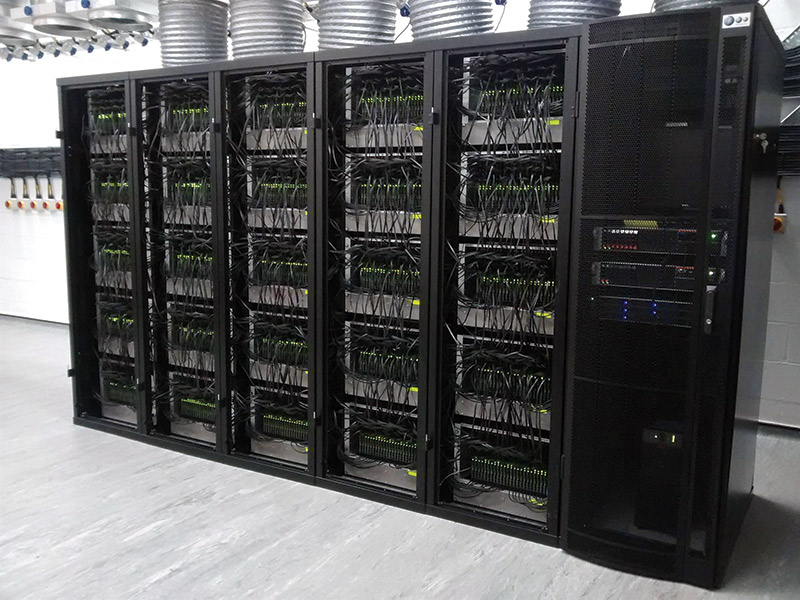
SpiNNaker machine. This half million core computer (shown with its doors removed) is suitable for spiking neural networks up to hundreds of millions of neurons, roughly equal to a mouse brain. It is openly available — at no cost — as part of the human brain project. (Courtesy of the University of Manchester.)
It’s anyone’s guess where this research will lead. Will it finally solve the greatest question of today, unraveling the mystery that is the mind? Will it lead to more and better neuromorphic machines and perhaps to an artificial neocortex as described in the story presented here?
The question of machine consciousness is still an open one. Will we be able to distinguish human from machine consciousness? If you believe the theories discussed in the story (which, by the way, are real), you might believe that it’s possible. I’m not so sure.
After reading this story, a friend of mine was puzzled by this same question. Was Lani Ross a real person or a neuromorphic machine? A clue early in the story indicated that an artificial neocortex had been produced by Neuroco seven years earlier and its disposition unknown. Was this the basis of a neuromorphic hubot that later became a bio-scientist, perhaps Lani? Was seven years enough time for a virgin neocortex to become intelligent and conscious?
Lani’s past was unknown except for the fact that she was an educated scientist and came from a distant place. So, this leaves open the possibility that Lani came from another country and was, in fact, an alien. This would explain why she wanted to become a citizen. However, it is not clear if all people or entities at that time wishing to become citizens needed to submit to a consciousness test, or was it just for neuromorphic machines?
I must confess to possibly leading the reader down the garden path. I believe that, even in the future, consciousness will be reserved for humans. So ... is the heroine really an intelligent human being or not? Lani’s tears are evidence that she is.
Only in an illusory fairyland will clever hubots achieve this wonderment of evolution: consciousness. Still, it remains an interesting subject for discourse.
My friend suggested that if such a consciousness test exists, it might be profitably applied to certain humans. That, however, is a subject for another time. SV
The Author
The writer is a retired engineering science professor living in Wisconsin. He can be reached via email at steber@execpc.com with “neuron” in the title line, to avoid Lani’s scrutiny and the spam blocker.
Reference
IEEE Spectrum, Special Report, “Can We Copy the Brain?” June 2017.
Article Comments